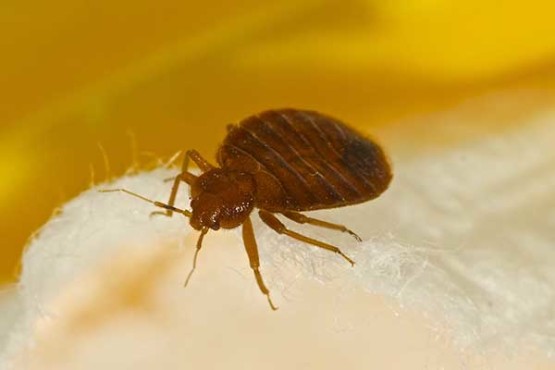

Bed Bug Treatment
Bed Bugs are about 1/5 to 1/8 inches, oval, broad, and flat. Female bed bugs tend to have a more rounded rear end, while males are more pointed. Females also tend to be slightly larger than the males. They range in color from mahogany to rusty brown. If you see a bed bug before it eats, it may appear to be almost pale or translucent, but after feeding on blood, its color will be bright red. Newly hatched nymphs are translucent and almost impossible to spot. They give off a 'musty sweetish' odor which can be detectable if there is a large infestation.
Bed Bugs feed mostly at night (although they will also feed during the day if conditions are right) and are attracted to carbon dioxide (CO2) and warmth. This means we serve as perfect attractants to bed bugs. Attracted by the CO2 we exhale and our body heat, bed bugs emerge from their hiding places, pierce our skin, and proceed to suck our blood.
This feeding can take anywhere from 3 to 10 minutes. One of the reasons you don't feel the bite is because its saliva contains an anesthetic which numbs your skin as it feeds. Some people are allergic to the saliva and may experience large swellings on the skin that itch and may become irritated and infected when scratched. However, other people may have no reaction at all, giving the appearance that one person is being eaten alive while another person sleeping in the same bed is not being bitten at all.
As far as insects are concerned, Bed Bugs are extremely successful hitch-hikers. They can be introduced into your home in used furniture, baggage, boxes, and suitcases. They can hitch-hike on visitor's clothing or crawl through walls voids, electrical outlets, on cables wires, and on plumbing from infested units in your complex. They can be brought in by your kids backpack from school or your spouse's briefcase from work. Once you find out you have bed bugs, it is often hard to pinpoint how they were originally brought into your home because there are just so many ways that they could have found their way in.
Bed Bugs like to stay close to their food source (which is unfortunately you) so it is common that at least 70% of bed bugs are infesting your mattress or box spring. Yuck! One way to combat this and keep from being bitten is to put bed bug certified encasements on both your mattress and box springs. Only putting encasements on the mattress is not recommended as there are so many hiding places a bed bug can hide in a box spring.
Deciding that your home is free of bed bugs because you do not have bites is not advisable since as stated before, not everyone has a reaction to getting bitten. Of course, finding a live bed bug is a pretty good indicator that you do. But considering they are not the easiest bugs to find, there are other ways. Look for cast skins (they cast off their own skin as they pass through each of their growth phases), fecal spots (small brownish spots), and blood spots on the sheets. When looking for evidence, be sure to look in the seams of the mattress and box spring, under the mattress, and around the head board. Don't make the mistake of limiting your inspection to just the bed though. Remember about 70% of the bed bugs will probably be found in your bed. That means 30% of the bed bugs may still be found in other areas. Look around baseboards, around window sills, in furniture, dressers, closets, and behind wall hangings. It is also recommended to inspect adjoining rooms or even other units in the building that share a wall (including units above and below yours).
Once it is determined you have bed bugs, quick action is required to keep the bed bug infestation from getting worse. Bed Bugs will not go away on their own, and they are one of the few pests everyone agrees cannot be eliminated with a'Do It Yourself' treatment. A professional treatment is necessary. There are many treatments offered by professional companies including chemical treatments, heat treatments, and fumigation. Each method has its pros and cons, and only youcan decide which one is best for you.
At Preferred, we offer both chemical treatment and fumigation to help you get rid of your bed bug problems. We understand that bed bugs not only take a physical toll by feeding off you and your loved ones, but also an emotional toll because of the stress dealing with bed bugs and the stigma attached to having them. If you suspect you have bed bugs, call us today for an inspection and let us help you once again have a good night's sleep.